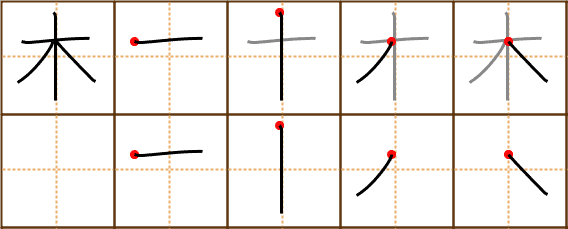Readings: モク・ボク (Onyomi), き / こ (Kunyomi)
Meaning: tree, wood
The kanji 木 means “tree” or “wood” and is one of the most common nature-related characters in Japanese. It’s used in words like 木曜日 (Thursday), 木材 (lumber), and 木 (tree).
View JLPT N5 Kanji ListKanji Details
| Radical | 木 (tree) |
|---|---|
| Strokes | 4 |
| JLPT Level | N5 |
| Grade | 1st Grade |
Readings
| Onyomi | モク・ボク |
|---|---|
| Kunyomi | き / こ |
How to Write – Stroke Order
This kanji is a pictograph of a tree with roots and branches. It’s easy to write and very frequently used.
- Start with the top vertical stroke
- Add the horizontal and diagonal branches

Example Sentences
Japanese: 木の下で休みましょう。
Kana: きのしたでやすみましょう。
Romaji: Ki no shita de yasumimashou.
English: Let’s rest under the tree.
Japanese: 木曜日はテストがあります。
Kana: もくようびはテストがあります。
Romaji: Mokuyoubi wa tesuto ga arimasu.
English: There is a test on Thursday.
Japanese: 木を見ています。
Kana: きをみています。
Romaji: Ki o miteimasu.
English: I am looking at the tree.
Vocabulary Using 木
| Word | Reading | Meaning |
|---|---|---|
| 木 | き | tree |
| 木曜日 | もくようび | Thursday |
| 木材 | もくざい | wood, lumber |
| 木の葉 | このは | leaves of a tree |
| 植木 | うえき | garden tree |
🔗 N5 Grammar & Vocabulary
I’m a software engineer based in Japan, with experience in developing web and mobile applications. I’m passionate about technology, especially in DevOps, AI, and app development using platforms like AWS, Flutter, and Node.js. My goal is to build a website that shares knowledge about the Japanese language and IT, helping everyone learn and grow more easily in the digital era.